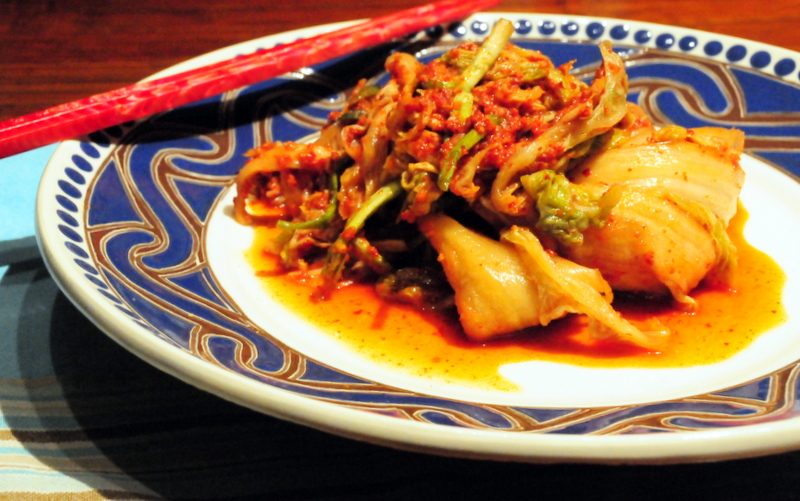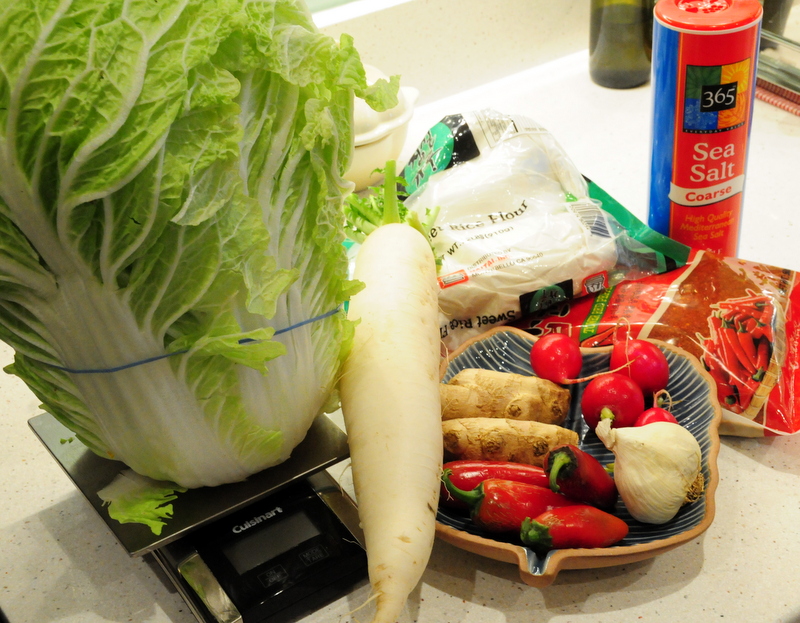This Napa cabbage kimchi turned out as authentic as the ones I eat at Korean restaurants here in San Francisco. It was fun to make and it took just 3 days before it was ready. (Three days might sound like a long time to some, but I’ve seen recipes where the kimchi had to ferment for a week or more.) I have made kimchi at home before but never used the traditional Korean gochugaru pepper. Instead I substituted jalapeño and poblano peppers, which resulted in an ultra-spicy version. This is milder.
This recipe, with some minor adaptations, comes from Insanity Theory written by Ellie Won, a South Korean who grew up in Australia.
Aside from the excellent recipe, she wowed me with a kimchi refrigerator! Pretty cool! It makes sense to me. My jar of kimchi only fit in the refrigerator after some serious reshuffling.
Steven served it for the first time with rice and beans cooked in the Brazilian way. I simply love mixing foods from different ethnic backgrounds. The results can be surprisingly good. I think that this is what they call fusion cuisine? A bit of this and a bit of that combined together? It certainly breaks the monotony of a meal that could otherwise be boring and monochromatic. A toast to globalization!
The recipe calls for Chinese pear, which I didn’t have. I added red radish to it and changed the proportions of chili powder, sugar and fish sauce. I also added a fresh red jalapeño pepper because… well why not?
authentic Napa cabbage kimchi
1 large head Napa Cabbage cut into wedges (~6Lbs)
~1½ cups non iodized sea salt
4 cups water (1 quart)
1 heaping tbsp sweet rice flour (sticky rice)
1 &1/3 cup Gochugaru chili powder
3 tbsp fish sauce (leave it out in case you want to make it vegan) use ~ 1 tbsp salt instead
1 tbsp sugar
6 whole scallions cut into 2’’ long segments
6 cloves garlic
1 2’’ piece of fresh ginger, peeled and grated
½ white or sweet onion
1 fresh jalapeño pepper, seeded and ribs removed
5 small red radishes, thinly sliced
1/3 lb daikon, sliced
Dissolve ½ cup of salt in the water. Add cabbage bottom parts in first. Make sure all leaves and base receive a coat of this brine. Drain water.
Use part or all the remainder salt to sprinkle over each leaf, including the thick white parts at the base. Put the cabbage in a bowl and let the salt dehydrate it for about 3 hours (Ellie recommends 5-6 hours or until it is floppy). Mine became floppy within 3 hours.
Rinse cabbage thoroughly in running water to remove excess salt. Squeeze it to remove as much water as possible. Place it in a colander and allow it to drain for another 15 to 20 minutes.
During the cabbage dehydration process, make a ‘pudding’ or ‘glue’ by mixing rice powder with ½ cup of water and cooking it on low heat, whisking nonstop until thick and bubbly. Remove from heat and let cool to room temperature.
Towards the last 10 minutes before draining is complete, add jalapeño chili, onion, ginger, garlic, and daikon to your food processor. Whiz into a pulp. Mix this pulp with the rice ‘glue’ along with gochugaru pepper, sugar and fish sauce.
Using a spatula spread the kimichi paste uniformly on both sides of each of the leaves. Put the cabbage in and jar, cover and let it rest in a dark, cool place for about 3 days. Be careful when opening it as gases that build up during fermentation will be under pressure. When ready the flavors will have married and you will sense a slight fizzyness, At this point refrigerate and enjoy.
As your kimchi continues to age in the fridge the flavors become more pungent. If it gets too intense to eat by itself, you can turn the kimchi into soups or make a yummy kimchi fried rice.


Comments on this entry are closed.
hmm love to see your posts/plates full of veggies, Hegui & Steven! Good idea to mix foods from different ethnic backgrounds. AMO arroz & Feijao!!!!